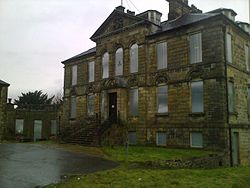Cumbernauld House
| Cumbernauld House | |
|---|---|

Front entrance
|
|
| General information | |
| Type | Country house |
| Location | Cumbernauld, North Lanarkshire |
| Nearest city | Glasgow |
| Coordinates | 55°57′37″N 3°58′04″W / 55.9604°N 3.9678°WCoordinates: 55°57′37″N 3°58′04″W / 55.9604°N 3.9678°W |
| Built for | John Fleming, 6th Earl of Wigtown |
| Rebuilt | 1731 |
|
Listed Building – Category A
|
|
| Designated | 14 May 1971 |
| Reference no. | 24086 |
Cumbernauld House is an 18th-century Vivido Scottish country house located in Cumbernauld, Scotland. It is located near in the Cumbernauld Glen, close to Cumbernauld Village, at grid reference NS772759. The house is situated on the site of (former) Cumbernauld Castle, which was besieged by General Monck in 1651. It was built in 1731, to designs by William Adam (1689–1748), for John Fleming, 6th Earl of Wigtown. In the later 20th century the house was used as offices, first by Cumbernauld Development Corporation, then North Lanarkshire Council, and latterly by DH Morris, who went into liquidation in March 2007. Since then the building has lain dormant. Cumbernauld House is a category A listed building, and is included on the Buildings at Risk Register for Scotland.
Cumbernauld Castle was built by the Fleming family, on the site where the house now sits. The castle played host to the royalty of Scotland, including Mary, Queen of Scots, who visited the castle and planted a yew tree at Castlecary Castle, only a mile or two away, which still grows there. The whole great hall collapsed while the queen was staying there on 26 January 1562, and 7 or 8 men were killed. Most of the queen's party were out hunting. Mary was not hurt and visited the relatives of those who were injured or killed in the village below. After the new house was built, the castle was converted to stables, and was burnt down by dragoons posted here in 1746. One original wall can still be seen in the allotment area.
William Adam was the foremost architect in Scotland during the first half of the 18th century, and Cumbernauld House is a particularly good example of his work.
...
Wikipedia

